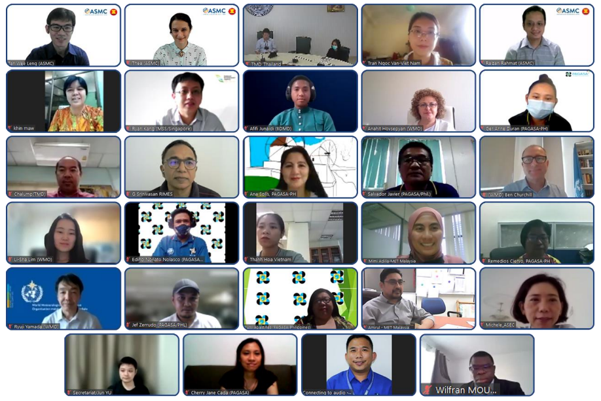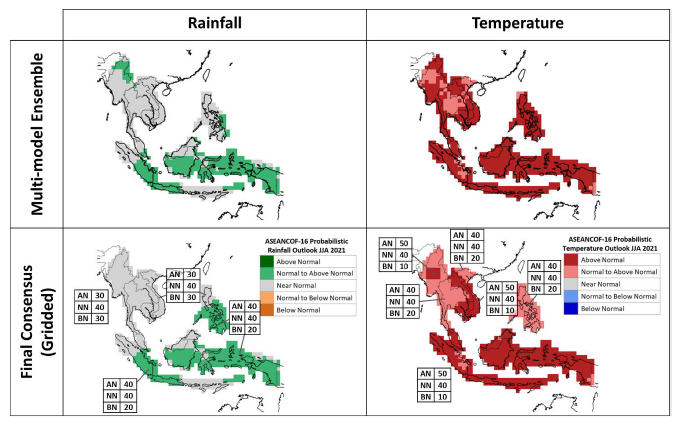22 SEP 2021
ASEANCOF
Summary of the Sixteenth Session of the ASEAN Climate Outlook Forum (Online, Singapore)

Participants of the ASEANCOF-16 (only those that shared their video were shown).
Introduction
The Sixteenth Session of the ASEAN Climate Outlook Forum (ASEANCOF-16), coordinated by ASMC, took place online on 20 and 24 May 2021. The forum was attended by over 30 participants from the ASEAN National Meteorological and Hydrological Services (NMHSs), World Meteorological Organization (WMO), ASEAN Secretariat and Regional Integrated Multi-Hazard Early Warning System (RIMES). While ASEANCOF sessions for the June–August period are usually held online over a single afternoon to discuss the consensus for the upcoming season, increased familiarity with virtual meetings allowed for an additional sharing session to be added to the ASEANCOF-16 programme.
Day 1
The first day of ASEANCOF-16 (20 May) covered a review of the previous outlook and a sharing session on the calibration and downscaling techniques used by ASEAN NMHSs for seasonal outlooks. The review of recent climate events and the previous outlook (Dec 2020 – Feb 2021) were based on national-level assessments by the NMHSs as well as a regional assessment by ASMC and the Node on Climate Monitoring of the South-East Asia Regional Climate Centre-Network (SEA RCC-Network). The remainder of the day focused on the implementation of objective seasonal outlooks.
After an introductory presentation by Dr Govindarajalu Srinivasan (Chief Scientist, RIMES), representatives of the NHMSs from the Philippines, Singapore, Thailand, and Viet Nam shared techniques that were currently being researched or used operationally in their NHMS. Of these, the Climate Predictability Tool (CPT) by the International Research Institute for Climate and Society (IRI), Columbia University, was currently being used by some of the presenting NMHSs to improve the skill of their seasonal outlooks. Presenters from Singapore and Viet Nam also focused on the calibration of temperature outlooks, which appeared more straightforward to calibrate as compared to rainfall outlooks. Dr Thea Turkington (Senior Research Scientist, ASMC) then shared the progress and plans for ASEANCOF’s shift towards objective seasonal outlooks, which included forming of the ASEANCOF Working Group. When asked where the priority should be placed for ASEANCOF’s shift towards objective seasonal outlooks, just over half (57%) of respondents thought this should be ‘calibration and downscaling techniques’, followed by ‘developing and disseminating standard operating procedures and guidelines’ (29%). Many participants also responded positively to the statement that ‘ASEANCOF would be a good platform for experts to share the latest advances in seasonal outlooks.
Day 2
The focus of the second day (24 May) was reaching a regional consensus on the region’s climate drivers, and the June–August 2021 rainfall and temperature outlooks. Prior to the forum, NMHSs filled out a detailed questionnaire on the upcoming season. Answers to this questionnaire were then used as the basis for the discussion on climate drivers while a gridded multi-model ensemble (dynamical seasonal models from ECMWF, UKMO, NCEP, JMA and ECCC global-producing centres) was used as the basis for the rainfall and temperature outlooks.
Multi-model ensemble (top) was used as a basis for the final consensus outlook for June – August 2021 (bottom).
Ending off ASEANCOF-16 were updates from the nodes of the SEA RCC-Network. The Node on Climate Monitoring (led by PAGASA, Philippines) presented the contents of the climate monitoring website: Southeast Asia Climate Monitoring. The Node on Long-Range Forecasting (led by MSS, Singapore) presented the newly added ENSO outlook page and a potential Standardized Precipitation Index (SPI) forecast product. Via a poll, the NMHSs voted that they preferred to have both a single-month SPI (SPI-1) and a three-month SPI (SPI-3), with the latter being a combination of one observation and two forecast months.
Conclusion
Overall, ASEANCOF-16 showcased calibration and downscaling techniques currently being used by ASEAN NMHSs as part of the transition to objective seasonal outlooks for ASEANCOF. Future ASEANCOF sessions will continue working towards implementing objective outlooks for the region.
The ASEANCOF Consensus Statement for JJA 2021 can be found here.